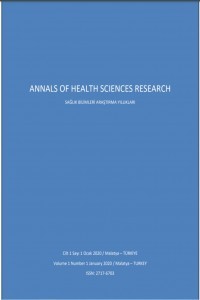Elastomerik Ölçü Materyalleri Dezenfeksiyonu ve Raf Ömrü
Elastomerik Ölçü Materyali, Dezenfeksiyon, Raf Ömrü
Disinfection of Elastomeric Impression Materials and Their Shelf Life
Elastomeric İmpression Materials, Disinfection, Shelf Life,
___
- Suprono MS, Kattadiyil MT, Goodacre CJ, Winer MS. Effect of disenfection on irreversible hydrocolloid and alternative impression materials and the resultant gypsum casts. J Prosthet Dent 2012; 108: 250-8.
- Thota KK, Jasthi S, Ravuri R, Tella S. A comparative evaluation of the dimensional stability of three different elastomeric impression materials after autoclaving–an invitro study. J Clin Diagn Res 2014; 8: ZC48.
- Choi YR, Kim KN, Kim KM. The disinfection of impression materials by using microwave irradiation and hydrogen peroxide. J Prosthet Dent 2014; 112: 981–987.
- Silva SMLM Da, Salvador MCG. Effect of the disinfection technique on the linear dimensional stability of dental impression materials. J Appl Oral Sci 2004; 12: 244-9.
- Kalantari MH, Malekzadeh A, Emami A. The effect of disinfection with sodium hypochlorite 0.5% on dimensional impression materials of speedex and irasil. J Dent 2014; 15: 98. condensation silicone
- Pal PK, Kamble SS, Chaurasia RR, Chaurasia VR, Tiwari S. Evaluation of different disinfactants on dimensional accuracy and surface quality of type ıv gypsum casts retrieved from elastomeric impression materials. J Int Oral Health 2014; 6: 77–81.
- Godbole SR, Dahane TM, Patidar NA, Nimonkar SV. Valuation of the effect of ultraviolet disinfection on dimensional stability of the polyvinyl silioxane impressions: an in-vitro study. J Clin Diagn Res 2014; 8: ZC73.
- Goel K, Gupta R, Solanki J, Nayak MG. A comparative study between microwave irradiation and sodium hypochlorite chemical disinfection: A prosthodontic view. J Clin Diagn Res 2014; 8: ZC42-6.
- Nassar U, Chow AK. Surface detail reproduction and effect of disinfectant and long‐term storage on the dimensional stability of a novel vinyl polyether silicone ımpression material. J Prosthodont 2014; 1-5.
- Millar BJ, Deb S. Effect of autoclave sterilisation on the dimensional stability and tear strength of three silicone ımpression materials. Open J Stomatol 2014; 4: 518.
- Bhasin A, Vinod V, Bhasin V, Mathew X, Sajjan S, Ahmed ST. Evaluation of effectiveness of microwave irradiation for disinfection of silicone elastomeric impression material. J Indian Prosthodont Soc 2013; 13: 89–94.
- Nassar U, Oko A, Adeeb A, El-Rich A, Flores-Mir C. An in vitro study on thr dimensional stability of a vinyl polyether silicone impression material over a prolonged storage period. J Prosthet Dent 2013; 109: 172-178.
- Anand, V. A comparative evaluation of disinfection effect of exposures to ultra-violet light and direct current glow discharge on Candida Albicans colonies coated over elastomeric impression material: An in vitro study. J Pharm Bioallied Sci 2013; 5: 80.
- Reddy SM, Vijitha D, Karthikeyan S, Balasubramanian R, Satish A. Evaluation of dimensional stability and accuracy of autoclavable polyvinyl siloxane impression material. J Indian Prosthodont Soc 2013; 13: 546–550.
- Shetty S, Kamat G, Shetty R. Wettability changes in polyether impression materials subjected to immersion disinfection. Dent Res J 2013; 10: 539.
- Bharathi M, Mallikarjun M. Comparsion of efficacy of gluteraldehyde and UV light disinfection and their effect on dimensional stability of polyvinily silioxane impressions an in-vitro study. Annals and Essences of dentistry 2011; 3: 13-15.
- Surendra GP, Anjum A, Babu CS, Shetty S. Evaluation of dimensional stability of autoclavable elastomeric impression material. J Indian Prosthodont Soc 2011; 11: 63-66.
- Saber FS, Abolfazli N, Kohsoltani M. The effect of disinfection by spray atomization on dimensional accuracy of condensation silicone impressions. J Dent Res Dent Clin Dent 2010; 4: 124-129.
- Stober T, Johnson GH, Schmitter M. Accuracy of the newly formulated vinyl siloxanether elastomeric impression material. J Prosthet Dent 2010; 103: 228- 239.
- Melilli D, Rallo A, Cassaro A, Pizzo G. The effect of immersion disinfection procedures on dimensional stability of two elastomeric impression materials. J Oral Sci 2008; 50: 441-446.
- Yilmaz H, Aydin C, Gul B, Yilmaz C, Semiz M. Effect of disinfection on the dimensional stability of polyether impression materials: Basic science research. J Prosthodont 2007; 16: 473–479.
- Anusavice KJ, Shen C, Rawls HR. Impression materials. Phillips' Science of Dental Materials (Twelfth edition). St. Louis: Elsevier Saunders. 2013; 151-181.
- Hondrum SO. Changes in properties of nonaqueous elastomeric impression materials after storage of components. J Prosthet Dent 2001; 85: 73-81.
- Başlangıç: 2012
- Yayıncı: İnönü Üniversitesi
46,XX Testiküler Bozukluğu Olan Erkek Hasta: Bir Olgu Sunumu
Elçin Latife KURTOĞLU, Serap SAVACI, Cemal EKİCİ, Emine YAŞAR, Ali BEYTUR, Elif YEŞİLADA
Kronik Hastalığı Olan Çocuğa Sahip Ebeveynlerin Bakım Verme Yükü
Nesrin Ağkaya ALAHAN, Rukuye AYLAZ, Gülsüm YETİŞ
Yasir Furkan ÇAĞIN, Yüksel SEÇKİN, Emin BODAKÇİ, Mahmut ŞAHİN
Nadir Karşılaşılan Bir Endodontik Problem: Radiks Entomolaris
Engelli Çocuğu Olan Ailelerin Yaşam Kalitesi
Nedenleri ve Sonuçlarıyla Doğum Korkusu
Cinsel İstismar Mağduru Çocuklarla Çalışan Uzmanların Gözünden Mağdur Çocukların Özellikleri
Zekeriya ÇALIŞKAN, Mehmet SAĞLAM
Genel Cerrahi Hastalarında Ameliyat Sonrası Konstipasyon Riski
Atların Terapötik lı Kullanımı
Abdurrahman KÖSEMAN, İbrahim ŞEKER
